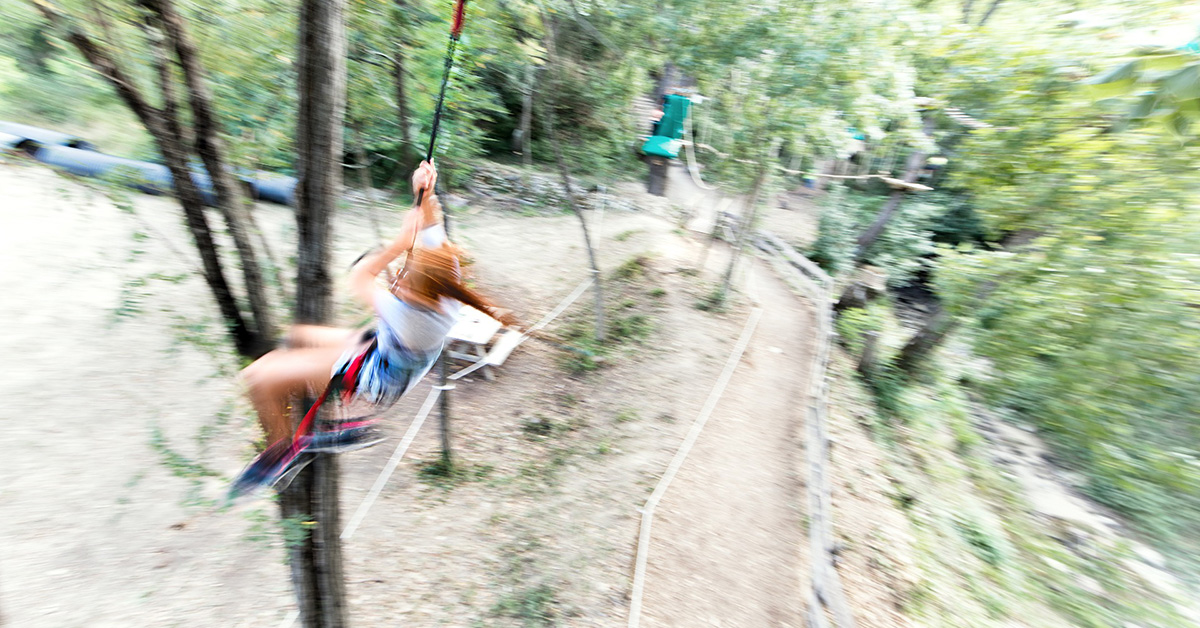
The zipSTOP and zipSTOP IR Zip Line Brakes were designed to provide a comfortable, reliable primary brake that enhances rider comfort and zip line throughput. Despite the fact that the zipSTOP is incredibly dependable, we know that it is only one part of a comprehensive and proper zip line braking system, which is part of the total zip line trip.
To comply with industry requirements and component installation instructions, each component within the overall ride must be installed, tested, and inspected.
Operations should have faith in their braking components, such as the zipSTOP, but be aware of the possibility of unforeseen primary brake breakdowns, such as third-party equipment deficiencies and human mistake in installation, maintenance, and use, among other things. Any zip line installation with an arrival speed over 10kph (6mph) and when utilizing a zipSTOP or zipSTOP IR Zip Line Brake requires an emergency arrest device (EAD) because to the risk of error. This criterion is based on ACCT and ASTM guidelines.
When it comes time to stop a participant at the conclusion of a zip line, speeds beyond 10kph (6mph) produce dynamic consequences on the human body. Understanding the pressures that can be exerted on the human body when transitioning from motion to a safe stop is critical, which is why a well-designed braking system and a proper emergency brake or EAD are required.
What is a Zip Line Brake System?
The Association for Challenge Course Technology (ACCT) and the American Society for Testing and Materials (ASTM) both have standards that apply to zip lines and the braking systems of zip lines. An EAD, also called an emergency brake, is mandated by ACCT standards in certain scenarios and ASTM requirements state that braking systems within a zip line must be fail-safe.
ACCT Definitions and Standards:
- Brake System: An arrangement of primary and emergency brakes that are designed to function together to arrest the motion of a person
- Emergency Brake: A brake located on a zip line that engages without any participant input upon failure of the primary brake in order to prevent serious injury or death
ACCT Standards state that a zip line brake system should be designed to address “The level of risk to the participant posed by the failure of the brake system or any of its components, including potential for pinching, binding, entanglement, etc.” The standards further state that “a qualified person” shall test the“brake system operational characteristics at the extremes of the design continuum for participant weight and arrival speed.”
ASTM Definitions and Standards
*Note: The below standards are relevant excerpts from ASTM F2291 and F2959
- Brake System: As it applies to aerial adventure courses, examples of braking systems include, but are not limited to: longitudinal friction brakes, disc or drum brakes, motor end brakes, either onboard or off-board of the patron-carrying vehicle or device. If the failure of the braking system results in an unsafe condition, then the braking system shall be fail-safe.
- Fail-Safe: Characteristic of an aerial adventure course, or component thereof, that is designed such that the normal and expected failure mode results in a
safe condition.
ASTM standards state that “the designer/engineer shall perform and document a ride analysis that illustrates how hazards to persons have been managed.” This report is to include hazard mitigation and a failure analysis in the form of “a Fault Tree Analysis, a Failure Mode and Effects Analysis (FMEA), or other accepted engineering practice.”
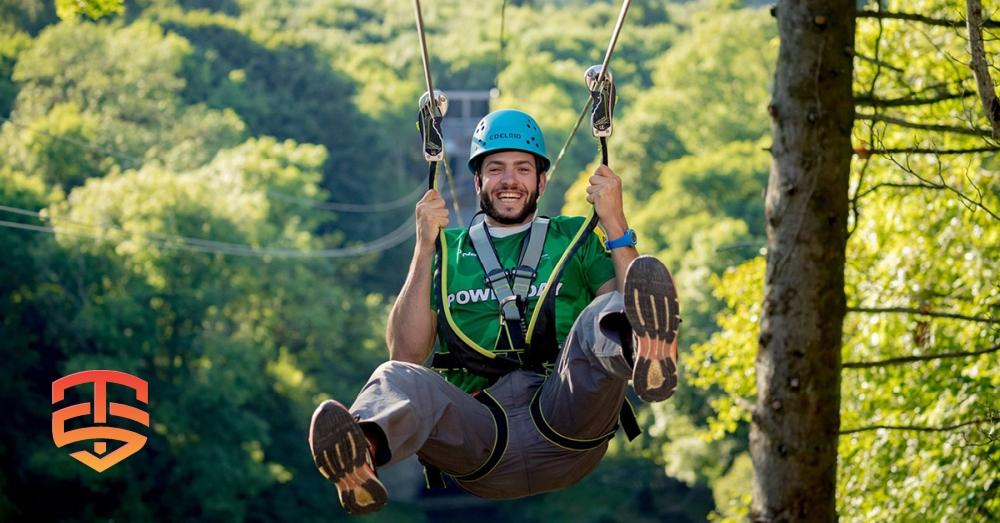
Arrival Speed Comparisons
Many zip lines are designed and manufactured to provide an exciting and enjoyable experience for participants. This usually results in zip line speeds, necessitating the use of a well-designed primary brake and an independent EAD. At the conclusion of a zip line, the zipSTOP and zipSTOP IR were designed to bring participants to a smooth, soft halt.
The zipSTOP IR, intended to accommodate rider arrival rates up to 60 kph, is the product that allows the fastest arrival speed (37 mph). Consider how a human falling from a specific height compares to a rider arriving at a speed of 60 kph (37 mph). Gravitational acceleration is a constant on Earth and is. A person falling from 4.7 stories above earth, approximately 14.2m, would reach speeds of 60 kph (16.7m/s or 37 mph) at a typical story height of 3m (10 foot).
Without a robust and thorough safety system in place, no one would consider jumping from a five-story building. Zip line speeds, likewise, necessitate a fully functional zip line brake mechanism. The zipSTOP Zip Line Brake is simply one part of a comprehensive zip line brake system; an EAD is also necessary and should not be overlooked.
Consider the chart below from a NASA research titled Human Tolerance to Impact Velocities to further show the critical requirement for both a primary brake and an EAD. This graph depicts the probability of surviving when hitting a hard flat surface at various speeds. It demonstrates that if a subject falls with a vertical velocity of (no horizontal velocity), he or she will be in the “zone of marginal survival,” which means there is a high risk of serious damage or death. This is the same speed as hitting a terminal structure at 60 kilometers per hour (37 miles per hour) or falling from 14.2 meters (47ft).
The “zone of guaranteed survival” still has a high risk of major injury, so don’t think of it as a safe, acceptable, or desirable conclusion. This chart emphasizes the risk of significant injury or death if your zip line lacks a good and comprehensive brake system, as well as the critical importance of including an EAD on your zip line. If the main brake fails, the EAD must provide safe braking on its own.
-
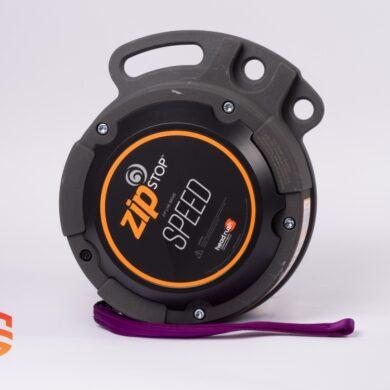 zipSTOP SPEED Zipline Brake | 50 – 72 kph€ 6.099,00 – € 6.349,00 Ex VAT
zipSTOP SPEED Zipline Brake | 50 – 72 kph€ 6.099,00 – € 6.349,00 Ex VAT -
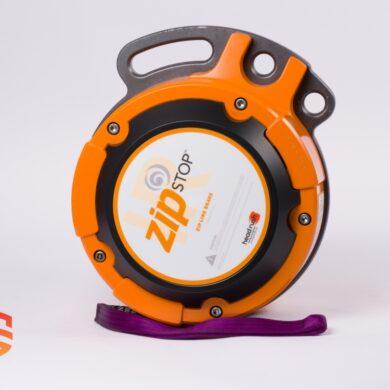 zipSTOP IR Zipline Brake | 24 – 60 kph€ 5.649,00 – € 5.799,00 Ex VAT
zipSTOP IR Zipline Brake | 24 – 60 kph€ 5.649,00 – € 5.799,00 Ex VAT -
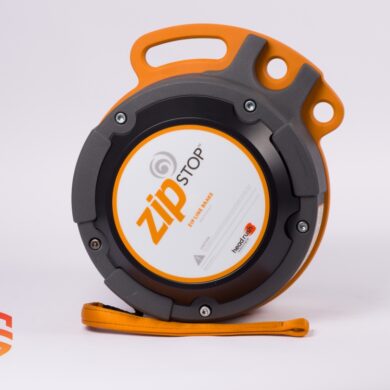 zipSTOP Zipline Brake | 0 – 36 kph€ 5.249,00 – € 5.499,00 Ex VAT
zipSTOP Zipline Brake | 0 – 36 kph€ 5.249,00 – € 5.499,00 Ex VAT
We recognize that most zip lines do not have arrival speeds of 60 kilometers per hour (37mph). Even an average arrival speed of 40kph (25mph) can result in a perilous situation. Using the same analogy, a person arriving at a speed of 40kph (11.2m/s or 25mph) is similar to falling from a height of 6m (20ft), or two storeys. This is right on the cusp of transitioning from definite to improbable survival. Again, most individuals would not feel safe jumping from that height if there were no safety precautions in place.
The graphs below show the relationship between arrival velocities and free fall distances. These figures can be used to estimate zip line arrival times and determine how far a passenger is “falling” when they reach at a terminal platform. Figure 3 illustrates how a rider riding at 30 mph has the same velocity as someone falling from a height of 30 feet.
Why Aren’t Guide-operated Emergency Brakes Advisable? A primary brake on a zip line is designed to successfully bring any participant to a safe stop. A appropriate EAD is required regardless of the kind of primary brake to defend against unforeseen primary brake failures. For instance, if a person passes out on a zip line using hand braking as the primary brake, how will they be stopped at the end of the zip line? What if a rat chewed through a zipSTOP’s redirection line, cutting it off from the rest of the braking system? A backup system must be in place to bring all passengers to a safe stop.
Many zip line operators send a guide down before any passengers to get at the terminal platform so that they can greet their passengers at the end of the journey. What is that guide’s emergency brake if he or she functions as an emergency brake for incoming participants? We’ve heard of at least one guide who was struck by lightning and rendered unconscious during the descent, making hand braking impossible.
It’s anecdotal, but zip line guides are more likely than participants to be gravely wounded. The main reason is because they ride zip lines more frequently than the average participant, increasing their exposure. It’s comparable to the notion that experienced backcountry skiers are more likely to get caught in an avalanche since their exposure time in avalanche terrain is so much longer. The longer you spend doing something dangerous, the more likely something bad will happen. If something prevented a primary brake from working as intended, the person who rode the zip line the most was statistically the most likely to be affected. Guides should be provided the same safeguards as paying customers in order to protect them. As a result, guide initiated emergency brakes are not recommended as EADs.
Guide activated EADs are also not suggested due to the greater risk of human mistake when attempting to activate the EAD, such as failing to reset a manual brake or not activating a brake in time. A prusik knot is a popular backup, but it requires the guide to tug the knot to activate. Consider the circumstances in which this backup would be required. A guide must trigger the prusik knot in a couple of seconds if the primary brake fails.
Consider a scenario in which a guide-activated emergency arrest device is required. When the participant reaches the braking zone, they are traveling at 60 kilometers per hour (37 miles per hour), and the primary brake does not deploy. The zipSTOP IR’s maximum braking distance is 20 meters (65 feet), and the participant will cover that distance in 1.2 seconds. Before the rider reaches the end of the line, the guide is unlikely to use the emergency brake. The upper average time for a single blink of the eye is 0.4 seconds, according to the Harvard Database of Useful Biological Numbers. To put it another way, the guide has the equivalent of three blinks to respond and trigger an emergency stop. To say the least, that reaction time would be incredible.
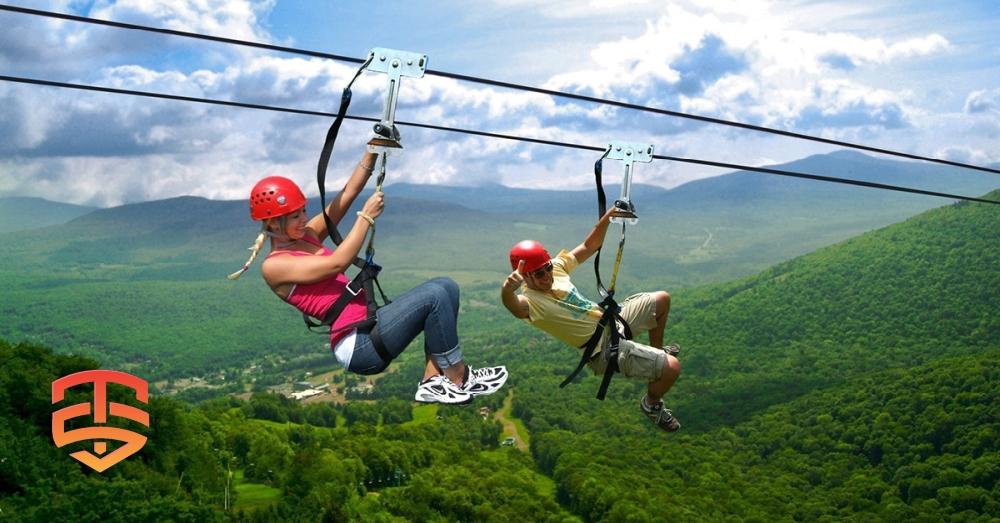
G-Loads Experienced During Braking
Many factors influence whether or not a rider suffers major harm or dies during terminal braking. These may include the reason the participant is being stopped, the rider’s orientation, the type of hardware being used, and so on. The g-load, or the sense of weight felt by deceleration, is a useful parameter for understanding the forces exerted on a cyclist during braking. A person feels 1 G vertically when standing on the ground (their own body weight). When a motorist slams on the brakes, high horizontal g-loads are felt, while low g-loads are felt when a driver stops carefully. The g-loads experienced by an item that decelerates (stops) in a short distance are greater than those experienced by an object that slows down over a long distance.
When decelerating in the +X direction, as most zip lines do when braking, a participant is allowed to experience 6 times the force of gravity (6 G) according to ASTM F2291 (see Figure 4). Within the zip line industry, however, it is commonly established that if a person experiences 6 G when braking, they will swing upward and perhaps contact the zip line rope. Due to rider swing up and comfort, any braking scenario with a zipSTOP or zipSTOP IR where a participant encounters greater than 2.5 G is not suggested. The Braking Distance Minimum (BD MIN) line on the Stop Distance Charts in the zipSTOP Zip Line Brake Installation, Operation, and Maintenance Manual is determined by this limit.
Let’s take a theoretical look at how different braking systems create g-loads, taking into account the maximum g-loads as indicated by ASTM (6 G) and our (2.5 G). Remember that braking distance is crucial to comprehending g-loads. The g-loads experienced by an item that decelerates (stops) in a short distance are greater than those experienced by an object that slows down over a long distance.
Let’s take a look at a braking situation at the zipSTOP IR’s maximum speed to see how many Gs a rider might encounter. The primary brake fails to engage because a squirrel chewed through the redirection line. The guide would have 1.2 seconds to activate the back-up prusik knot. A prusik knot emergency brake, if functional, would stop the rider in around 0.5 meters (1.6ft). The rider will be subjected to 28.3 G, approximately 5 times the ASTM maximum. The rider would suffer 14 G even if the stopping distance was a whole meter (3.3ft). Again, we recognize that most zip lines do not have arrival speeds of 60 kilometers per hour (37mph). Even a more average arrival speed of around 40kph (25mph) can result in a hazardous situation. Using the same example, a person traveling at 40 kph (25 mph) will experience 13 G if they are stopped inside 0.5m (1.6ft). Consider what would happen if an ineffective EAD was employed, such as a cable clamp that would stop the rider in a much shorter distance.
Please keep in mind that the calculation method given is a simplified theoretical calculation that only shows the best-case g-load scenarios. The calculations are based on the participant decelerating at a consistent rate during the whole emergency braking distance. For example, if a participant moving at 38 kph (24 mph) is given a braking distance of 1 meter, they will experience 6 G. (3.3ft). This isn’t true in every emergency braking scenario.
A participant will experience a minimum and maximum g-load in reality. As the springs are compressed, the deceleration of a spring pack increases, resulting in higher deceleration and g-loads than computed in the example. A participant is also not permanently attached to a trolley, allowing the rider to swing and potentially increasing braking distance, lowering g-loads. Theoretical data can serve as a starting point, however there are other variables that influence emergency braking circumstances. As a result, real-world testing with purpose-built test equipment carried out by a qualified designer or engineer is the preferred method of confirming an EAD. ASTM F2137 Standard Practice for Measuring the Dynamic Characteristics of Amusement Rides and Devices outlines this type of testing.

How to Test a Primary Brake and EAD
The ACCT standards states that an emergency brake is: A brake located on a zip line that engages without any participant input upon failure of the primary brake in order to prevent serious injury or death. The standards do not specify certain types of devices or brands, and we does not endorse particular products. Every zip line installation is unique and different, and it is the responsibility of the installers, operators, and builders to ensure that the zipSTOP Zip Line Brake is installed and operated per ACCT and/or ASTM standards and the zipSTOP Operators Manual with an adequate EAD.
According to ACCT there are test requirements for a zip line brake system:
A qualified person shall design the methods, oversee the performance and assess the results of operational tests. All tests shall provide proof of the following:
- Brake system operational characteristics at the extreme of the design continuum for participant weight and arrival speed
- Confirmation that the brake system performs reliably and as designed
Since an emergency brake is part of a complete brake system, as defined by ACCT, it must be tested per the ACCT standards if: Upon failure of the primary brake, both of the following may occur:
- The participant arrives at the zip line landing area at a speed in excess of 6 mph (10 kph)
- The participant experiences unintended and/or harmful contact with terrain, objects or people in the zip line landing area
According to ASTM F1193 Performance Testing must be completed:
- Performance Testing – This should consist of a series of specified tests that can be used to determine that the newly erected ride or device conforms to the original design criteria
Since the original design criteria of the brake system is that it is fail-safe, it must be tested to prove that the brake system is indeed fail-safe. We Technologies recommend testing the efficacy of a proposed EAD by disconnecting the primary brake and sending a range of test weights (unmanned) down the zip line. Observe the arrival speed and the weights impacting the proposed EAD. Could serious injury or death occur, does it appear to result in a safe condition? If serious injury or death could occur or it does not result in a safe condition, it is not
an emergency arrest device.
It’s not stated directly in the ASTM or ACCT standards, but it should be noted that certain conditions can greatly affect arrival speed of a participant. Cold temperatures, wet conditions, and strong winds can all greatly increase the rider arrival speeds and should be considered during testing and accounted for by the primary brake and EAD
Conclusion
For a complete zip line braking system and risk mitigation, a primary brake and an EAD are required. In worst-case scenarios, having a properly designed, installed, and tested primary brake and EAD on your zip line could be the difference between life and death. This is one of the reasons why all zip line installations utilizing the zipSTOP and zipSTOP IR Zip Line Brakes require the use of EADs. This criterion is based on ACCT and ASTM guidelines.
These guidelines, as well as our EAD requirements, are intended to benefit the whole zip line industry. As zip lining becomes more popular, less danger, better reliability, and fewer occurrences of injury will help to boost confidence and improve the industry’s health. We propose undertaking physical tests and regular inspections to guarantee the efficacy of all braking systems, as well as ensuring your primary brake and EAD are well-designed for the worst-case situation.
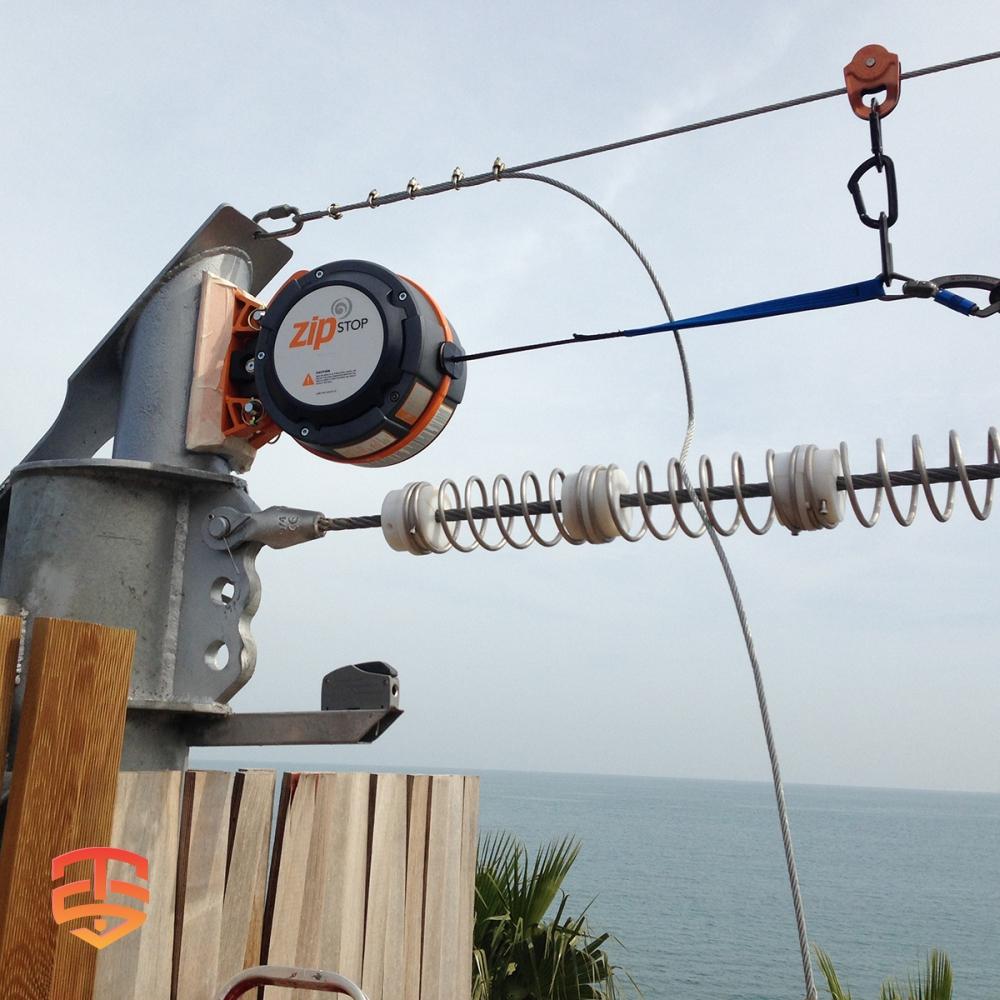
Zipline Safety Solutions
We deliver a complete professional Zipline system, from our Self-braking Magnetic Zipline Trolley to a safe Zipline Spring Brake.
We offer a full family of zip line brakes that increase throughput with a hands-free braking experience for zip line riders and operators, and a full ecosystem of zip line products to outfit the best zip line builds in the world. We use advanced technology to engineer and manufacture innovative adventure equipment for the outdoor, amusement and recreation industries.
Beyond the Basics: Unveiling Zipline Technology with Expert Analysis
Intrigued by the potential of Zipline technology? You’ve come to the right place! This article provides a solid foundation. But if you’re eager to delve deeper and gain insights from industry experts, keep reading…
- Zip Line Design: Components for a Complete System
- Considering operating and investing in a zipline?
- 9 Zipline Mistakes You Don’t Know You’re Making
- Magnetic Zipline Braking: A Revolutionary Way to Ensure Safe Rides
- Pros and Cons of Different Zip Line Brakes
- Expert Tips for Zip Line Brake Installations
- White Paper on Zipline Emergency Arrest Devices (EAD)
- The Importance of Optimizing Zip Line Design for Rider Speed
- Does your zip line need an emergency arrest device?
- The Magnetic Self-braking Zipline pulley
- Zipline Braking and landing considerations
- Why Zip Line Trolley Bearings Matter
- Whitepaper: Zipline Braking Dynamics
- Zip Line Installation: Give them the Best Ride
- How to startup a Successful Zip Line Business
-
 zipSTOP IR Zipline Brake | 24 – 60 kph€ 5.649,00 – € 5.799,00 Ex VAT
zipSTOP IR Zipline Brake | 24 – 60 kph€ 5.649,00 – € 5.799,00 Ex VAT -
 zipSTOP SPEED Zipline Brake | 50 – 72 kph€ 6.099,00 – € 6.349,00 Ex VAT
zipSTOP SPEED Zipline Brake | 50 – 72 kph€ 6.099,00 – € 6.349,00 Ex VAT -
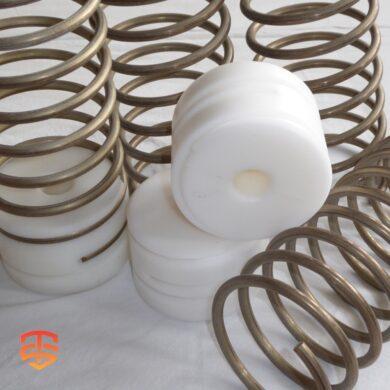 Spring Brake System | Primary & EAD zipline brake€ 80,00 Ex VAT
Spring Brake System | Primary & EAD zipline brake€ 80,00 Ex VAT







